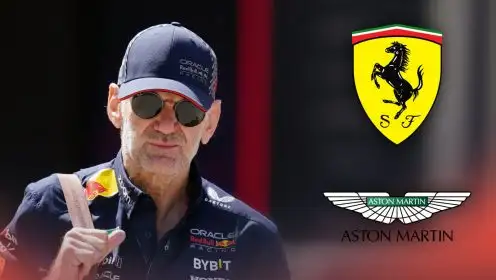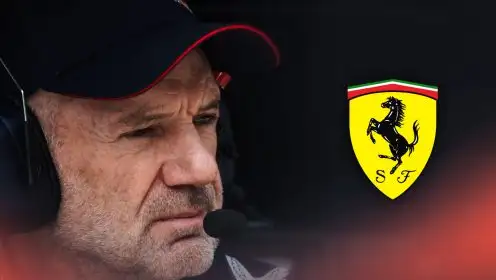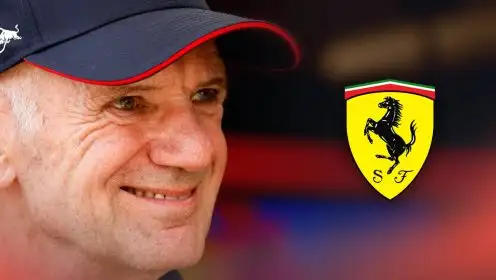Red Bull RB17: The £5million hypercar that now has Adrian Newey’s full focus

A side view of the Red Bull RB17.
The Red Bull RB17 is a hypercar project that is being overseen by Red Bull chief technical officer Adrian Newey, and now his departure from the team has been confirmed, the car will have his full focus until he departs.
Max Verstappen has made no secret about his aims to enter the 24 Hours of Le Mans in the future, potentially even in an RB17 once it gets unveiled to the world – as it is set to feature a host of Newey’s ‘greatest hits’ from his esteemed Formula 1 career in one single design.
What is the Red Bull RB17?
The Red Bull RB17 was announced at a press conference in June 2022 featuring Newey and Red Bull team principal Christian Horner, with a project that will utilise Newey’s world-renowned knowledge of ground effect aerodynamics in a track-only specification, with the RB17 being designed in conjunction with Red Bull Advanced Technologies.
The RB17 is so named to follow the naming convention of the team’s Formula 1 cars, but due to the 2021 Red Bull being named the RB16B and the 2022 car being named the RB18, this left a gap to fill – which the hypercar will make its own.
Newey has already completed a hypercar design in recent years, heading up the design process of the Aston Martin Valkyrie when the brand was partnered with Red Bull, but the RB17 will be designed under Red Bull’s own moniker.
What do we know about the technical specification of the Red Bull RB17?
Red Bull announced that the production of the RB17 will begin in 2025, and it will be a “track-only specification for the purest execution of an F1-inspired hypercar.”
It will be a two-seater powered by a V10 naturally aspirated engine that Red Bull say will produce in excess of 1,000bhp, supplemented by a 200bhp electric motor featuring an energy recovery system [ERS] that has now been a long-standing feature of Formula 1 cars.
The car itself will be designed around a carbon composite tub that will use ground effect aerodynamics – the same style used on Formula 1 cars – generating significant downforce from the floor the car, all while weighing less than 900kg.
Due to the lack of technical restrictions on the car, the RB17 will also feature some of Newey’s most famous Formula 1 innovations from his time in the sport, such as active suspension that propelled Williams to dominance in the early 1990s, as well as blown exhausts, an innovation that catapulted Red Bull towards the front of the field in 2009.
PlanetF1.com recommends
👉 F1 schedule: When is the next F1 race and where is it being held?
👉 Motorsport Triple Crown explained: Its prestigious races, history and only winner
Flexible skirts will also be used on the RB17 to maximise the ground effect aerodynamics in place.
Newey said of the RB17: “The RB17 distills everything we know about creating championship-winning Formula 1 cars into a package that delivers extreme levels of performance in a two-seat track car.
“Driven by our passion for performance at every level, the RB17 pushes design and technical boundaries far beyond what has been previously available to enthusiasts and collectors.”
How many will be made, and how much will the Red Bull RB17 cost?
Costs for the RB17 start at £5million (plus local taxes), and only 50 are being made at a rate of around 15 per year. Prospective buyers had been invited to register their interest to Red Bull themselves, but most have already been sold before production has even taken place.
RB17 owners will also gain access to Red Bull simulators, on-track training and further experiences as part of the price, and the team will offer direct maintenance and service support “tailored to each owner” and how often they will use the car.
What has Adrian Newey said about the Red Bull RB17?
Speaking on Red Bull’s in-house Talking Bull podcast in early 2024, Newey went into more detail about the specifics of what has been designed and what his goals are for the car.
“The challenge we set us ourselves is that adaptability of the car. But then ultimately, the car, if driven by a professional driver, is capable of Formula 1 lap times,” he said.
“It’s kind of mind-blowing in a way that this car, which is a two-seater, can produce that sort of performance.
“And that’s really been achieved by the usual key parameters of focusing on weight, so it’ll be less than 900 kilos, so much lighter than any normal road car, or track car.
“But at the same time, it will have 1000 horsepower, V10, normally aspirated, so it’ll sound awesome – but we then have a 200 horsepower electric motor, and that fulfils a variety of functions.
“Obviously, it’s an extra 200 horsepower, but it also smooths out the torque, smooths out the gear change, provides reverse gear, first gear, you can move off the starting motor, all the usual sorts of multifunctions.
“It will have active suspension, which it needs to have because the downforce we’re producing to achieve those lap times is immense.
“As a number, the [weight] it produces downforce is capped at 1.7 tonnes. So downforce is capped at almost twice its weight, and that’s simply because otherwise then it overloads the tyres. But it actually gets to that figure at about 150 miles an hour, so after that it starts to bleed off. It can actually produce its own weight in downforce by 120 miles an hour.
“It’s incredibly aerodynamically efficient, and to achieve that we’ve pulled all the levers. So it has a blown diffuser, active suspension too which is multifunction.
“Again, the purpose of the active suspension, it’s to give a very stable aerodynamic platform whilst maintaining reasonably sensible spring rates, so that you don’t get thrown from bump to bump, not nearly as stiff as a current Formula 1 car or an LMP car.
“So [it’s] relatively compliant, and it also offers the ability to tune the car, both aerodynamically by adjusting the ride heights and also in terms of how you change what we call the mechanical balance, which is the balance of grip between the front axle and the rear axle.
“So you can, in that way, make it a car that as I mentioned earlier is suitable for a wide range of driver techniques, styles, abilities.”
When will the Red Bull RB17 go on sale?
Production is due to start on the RB17 in early 2025, with Newey set to leave Red Bull once his work on the project is complete – and the first models are due to be put on sale in mid-2025.
Read next: Lewis Hamilton car collection: Take a closer look at his incredible private garage





